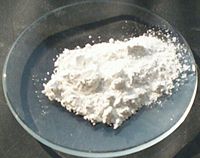Calcium hydroxide
| Calcium hydroxide | |
|---|---|
 |
|
| IUPAC name | Calcium hydroxide |
| Other names | Cal, calcium(II) hydroxide, hydrated lime, milk of lime, pickling lime, slaked lime |
| Identifiers | |
| CAS number | 1305-62-0 |
| Properties | |
| Molecular formula | Ca(OH)2 |
| Molar mass | 74.093 g/mol |
| Appearance | Soft white powder/Colourless liquid |
| Density | 2.211 g/cm3, solid |
| Melting point |
512 °C (Decomposes) |
| Boiling point |
N/A |
| Solubility in water | 0.185 g/100 cm3 Ksp = 7.9 × 10−6 |
| Basicity (pKb) | −2.37
pH=12.0–12.5 |
| Hazards | |
| EU classification | Corrosive (C) |
| R-phrases | R34, R36, R37, R38, R41. |
| S-phrases | S22, S26, S39, S45. |
| Flash point | Non-flammable. |
| Related compounds | |
| Other anions | None listed. |
| Other cations | None listed. |
| Related bases | Calcium oxide. |
| Except where noted otherwise, data are given for materials in their standard state (at 25 °C, 100 kPa) Infobox references |
|
Calcium hydroxide, traditionally called slaked lime, hydrated lime, or pickling lime, is a chemical compound with the chemical formula Ca(OH)2. It is a colourless crystal or white powder, and is obtained when calcium oxide (called lime or quicklime) is mixed, or "slaked" with water. It can also be precipitated by mixing an aqueous solution of calcium chloride and an aqueous solution of sodium hydroxide. The name of the natural, mineral form is portlandite. It is relatively rare mineral, known from some volcanic, plutonic and metamorphic rocks. Sometimes it arises on burning coal dumps, too.
When heated to 512 °C, the partial pressure of water in equilibrium with calcium hydroxide reaches 101 kPa and decomposes into calcium oxide and water.[1] A suspension of fine calcium hydroxide particles in water is called milk of lime. The solution is called lime water and is a medium strength base that reacts violently with acids and attacks many metals in presence of water. It turns milky if carbon dioxide is passed through, due to precipitation of calcium carbonate.
Contents |
Uses
Because of its strong basic properties, calcium hydroxide has many and varied uses:
- A flocculant, in water and sewage treatment and improvement of acid soils
- An ingredient in whitewash, mortar, and plaster
- An alkali used as a lye substitute in no-lye hair relaxers
- A chemical depilatory agent found in Nair
- An Calcium supplement in mineral fortified baby formulas
- A chemical reagent
- In Bordeaux mixture to neutralise the solution and form a long lasting fungicide.
- In the reef aquarium hobby for adding bio-available calcium in solution for calcium-using animals such as algae, snails, hard tube worms, and Corals (often referred to as Kalkwasser mix), and also to increase the alkalinity of the water.
- In the tanning industry for neutralization of acid, the liming of hides and skins and the flocculation of wastewater.
- In the petroleum refining industry for the manufacture of additives to oils (salicatic, sulphatic, fenatic)
- In the chemical industry for manufacture of calcium stearate
- In the food industry for processing water (for alcoholic and soft drinks)
- For clearing a brine of carbonates of calcium and magnesium in the manufacture of salt for food and pharmacopoeia
- In Native American and Latin American cooking, calcium hydroxide is called "cal". Corn cooked with cal becomes nixtamal which significantly increases its nutrition value, and is also considered tastier and easier to digest.
- In chewing Betel nut or coca leaves, calcium hydroxide is usually chewed alongside to keep the alkaloid stimulants chemically available for absorption by the body
- Similarly, Native Americans traditionally chewed tobacco leaves with calcium hydroxide derived from burnt shells to enhance the effects
- A filler
- In the petrochemical industry for manufacturing solid oil of various marks
- In the manufacture of brake pads
- In the manufacture of ebonite
- For preparation of dry mixes for painting and decorating
- In manufacturing mixes for pesticides
- In manufacturing the trademarked compound "Polikar", an antifungal and antimicrobial preservative for vegetables in storage
- In Dentistry, it is used as dressing in paste form used for anti-microbial effect during a dental root canal procedure. Calcium hydroxide is known to have a strong anti-microbial effect and is a bone-regeneration stimulant.[2]
- It has been proposed to add it to sea water in great quantities to reduce atmospheric CO2 and fight the greenhouse effect[1]
- Used as an acid suppressor in the production of metals. Lime is injected into the waste gas stream to neutralise acids such as fluorides and chlorides prior to being released to atmosphere
Health risks
An overexposure to calcium hydroxide can have life threatening effects:
- Difficulty in breathing
- Internal bleeding
- Hypotension
- Skeletal muscle paralysis, interference with actin-myosin system.
- An increase in blood pH, which is damaging to the internal organs.
References
- ↑ Halstead, P.E.; Moore, A.E. (1957). "The Thermal Dissociation Of Calcium Hydroxide". Journal of the Chemical Society 769: 3873. doi:.
- ↑ Gomes, Brenda; et al (2002). "In Vitro Antimicrobial Activity of Calcium Hydroxide Pastes and Their Vehicles Against Selected Microorganisms". Brazilian Dental Journal 13 (3). doi:. http://scielo.br/scielo.php?pid=S0103-64402002000300002&script=sci_arttext. Retrieved on 2008-02-05.
External links
- National Organic Standards Board Technical Advisory Panel (2002-04-04). "NOSB TAP Review: Calcium Hydroxid" (.PDF). Organic Materials Review Institute. Retrieved on 2008-02-05.
- MSDS Data Sheet
- Lime production process